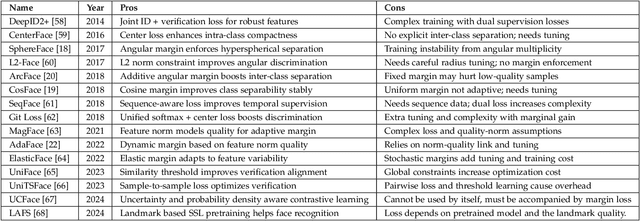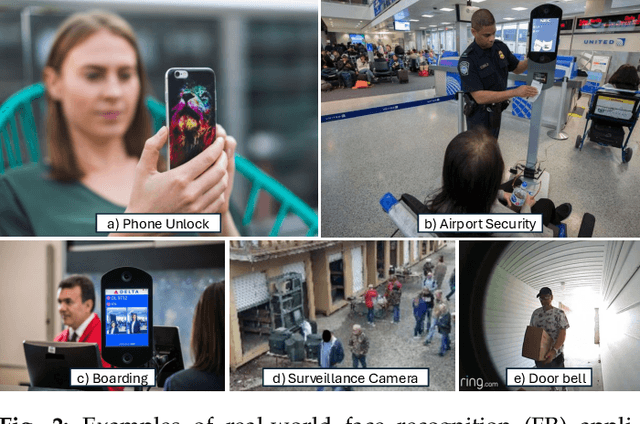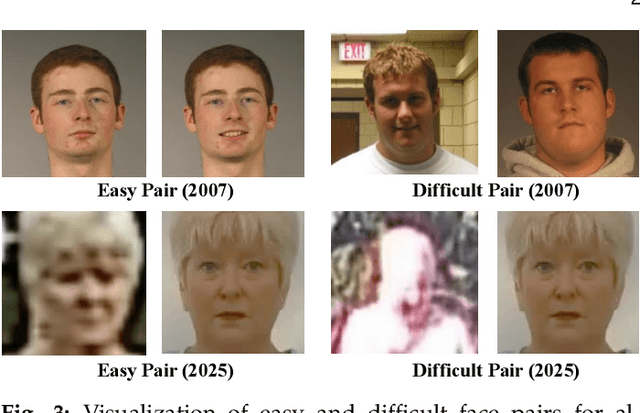Xiaoming Liu
Generalizable Object Re-Identification via Visual In-Context Prompting
Aug 28, 2025Abstract:Current object re-identification (ReID) methods train domain-specific models (e.g., for persons or vehicles), which lack generalization and demand costly labeled data for new categories. While self-supervised learning reduces annotation needs by learning instance-wise invariance, it struggles to capture \textit{identity-sensitive} features critical for ReID. This paper proposes Visual In-Context Prompting~(VICP), a novel framework where models trained on seen categories can directly generalize to unseen novel categories using only \textit{in-context examples} as prompts, without requiring parameter adaptation. VICP synergizes LLMs and vision foundation models~(VFM): LLMs infer semantic identity rules from few-shot positive/negative pairs through task-specific prompting, which then guides a VFM (\eg, DINO) to extract ID-discriminative features via \textit{dynamic visual prompts}. By aligning LLM-derived semantic concepts with the VFM's pre-trained prior, VICP enables generalization to novel categories, eliminating the need for dataset-specific retraining. To support evaluation, we introduce ShopID10K, a dataset of 10K object instances from e-commerce platforms, featuring multi-view images and cross-domain testing. Experiments on ShopID10K and diverse ReID benchmarks demonstrate that VICP outperforms baselines by a clear margin on unseen categories. Code is available at https://github.com/Hzzone/VICP.
HAMoBE: Hierarchical and Adaptive Mixture of Biometric Experts for Video-based Person ReID
Aug 07, 2025Abstract:Recently, research interest in person re-identification (ReID) has increasingly focused on video-based scenarios, which are essential for robust surveillance and security in varied and dynamic environments. However, existing video-based ReID methods often overlook the necessity of identifying and selecting the most discriminative features from both videos in a query-gallery pair for effective matching. To address this issue, we propose a novel Hierarchical and Adaptive Mixture of Biometric Experts (HAMoBE) framework, which leverages multi-layer features from a pre-trained large model (e.g., CLIP) and is designed to mimic human perceptual mechanisms by independently modeling key biometric features--appearance, static body shape, and dynamic gait--and adaptively integrating them. Specifically, HAMoBE includes two levels: the first level extracts low-level features from multi-layer representations provided by the frozen large model, while the second level consists of specialized experts focusing on long-term, short-term, and temporal features. To ensure robust matching, we introduce a new dual-input decision gating network that dynamically adjusts the contributions of each expert based on their relevance to the input scenarios. Extensive evaluations on benchmarks like MEVID demonstrate that our approach yields significant performance improvements (e.g., +13.0% Rank-1 accuracy).
A Quality-Guided Mixture of Score-Fusion Experts Framework for Human Recognition
Jul 31, 2025Abstract:Whole-body biometric recognition is a challenging multimodal task that integrates various biometric modalities, including face, gait, and body. This integration is essential for overcoming the limitations of unimodal systems. Traditionally, whole-body recognition involves deploying different models to process multiple modalities, achieving the final outcome by score-fusion (e.g., weighted averaging of similarity matrices from each model). However, these conventional methods may overlook the variations in score distributions of individual modalities, making it challenging to improve final performance. In this work, we present \textbf{Q}uality-guided \textbf{M}ixture of score-fusion \textbf{E}xperts (QME), a novel framework designed for improving whole-body biometric recognition performance through a learnable score-fusion strategy using a Mixture of Experts (MoE). We introduce a novel pseudo-quality loss for quality estimation with a modality-specific Quality Estimator (QE), and a score triplet loss to improve the metric performance. Extensive experiments on multiple whole-body biometric datasets demonstrate the effectiveness of our proposed approach, achieving state-of-the-art results across various metrics compared to baseline methods. Our method is effective for multimodal and multi-model, addressing key challenges such as model misalignment in the similarity score domain and variability in data quality.
50 Years of Automated Face Recognition
May 30, 2025



Abstract:Over the past 50 years, automated face recognition has evolved from rudimentary, handcrafted systems into sophisticated deep learning models that rival and often surpass human performance. This paper chronicles the history and technological progression of FR, from early geometric and statistical methods to modern deep neural architectures leveraging massive real and AI-generated datasets. We examine key innovations that have shaped the field, including developments in dataset, loss function, neural network design and feature fusion. We also analyze how the scale and diversity of training data influence model generalization, drawing connections between dataset growth and benchmark improvements. Recent advances have achieved remarkable milestones: state-of-the-art face verification systems now report False Negative Identification Rates of 0.13% against a 12.4 million gallery in NIST FRVT evaluations for 1:N visa-to-border matching. While recent advances have enabled remarkable accuracy in high- and low-quality face scenarios, numerous challenges persist. While remarkable progress has been achieved, several open research problems remain. We outline critical challenges and promising directions for future face recognition research, including scalability, multi-modal fusion, synthetic identity generation, and explainable systems.
TalkingHeadBench: A Multi-Modal Benchmark & Analysis of Talking-Head DeepFake Detection
May 30, 2025Abstract:The rapid advancement of talking-head deepfake generation fueled by advanced generative models has elevated the realism of synthetic videos to a level that poses substantial risks in domains such as media, politics, and finance. However, current benchmarks for deepfake talking-head detection fail to reflect this progress, relying on outdated generators and offering limited insight into model robustness and generalization. We introduce TalkingHeadBench, a comprehensive multi-model multi-generator benchmark and curated dataset designed to evaluate the performance of state-of-the-art detectors on the most advanced generators. Our dataset includes deepfakes synthesized by leading academic and commercial models and features carefully constructed protocols to assess generalization under distribution shifts in identity and generator characteristics. We benchmark a diverse set of existing detection methods, including CNNs, vision transformers, and temporal models, and analyze their robustness and generalization capabilities. In addition, we provide error analysis using Grad-CAM visualizations to expose common failure modes and detector biases. TalkingHeadBench is hosted on https://huggingface.co/datasets/luchaoqi/TalkingHeadBench with open access to all data splits and protocols. Our benchmark aims to accelerate research towards more robust and generalizable detection models in the face of rapidly evolving generative techniques.
BiggerGait: Unlocking Gait Recognition with Layer-wise Representations from Large Vision Models
May 23, 2025Abstract:Large vision models (LVM) based gait recognition has achieved impressive performance. However, existing LVM-based approaches may overemphasize gait priors while neglecting the intrinsic value of LVM itself, particularly the rich, distinct representations across its multi-layers. To adequately unlock LVM's potential, this work investigates the impact of layer-wise representations on downstream recognition tasks. Our analysis reveals that LVM's intermediate layers offer complementary properties across tasks, integrating them yields an impressive improvement even without rich well-designed gait priors. Building on this insight, we propose a simple and universal baseline for LVM-based gait recognition, termed BiggerGait. Comprehensive evaluations on CCPG, CAISA-B*, SUSTech1K, and CCGR\_MINI validate the superiority of BiggerGait across both within- and cross-domain tasks, establishing it as a simple yet practical baseline for gait representation learning. All the models and code will be publicly available.
Benchmarking Unified Face Attack Detection via Hierarchical Prompt Tuning
May 19, 2025Abstract:Presentation Attack Detection and Face Forgery Detection are designed to protect face data from physical media-based Presentation Attacks and digital editing-based DeepFakes respectively. But separate training of these two models makes them vulnerable to unknown attacks and burdens deployment environments. The lack of a Unified Face Attack Detection model to handle both types of attacks is mainly due to two factors. First, there's a lack of adequate benchmarks for models to explore. Existing UAD datasets have limited attack types and samples, restricting the model's ability to address advanced threats. To address this, we propose UniAttackDataPlus (UniAttackData+), the most extensive and sophisticated collection of forgery techniques to date. It includes 2,875 identities and their 54 kinds of falsified samples, totaling 697,347 videos. Second, there's a lack of a reliable classification criterion. Current methods try to find an arbitrary criterion within the same semantic space, which fails when encountering diverse attacks. So, we present a novel Visual-Language Model-based Hierarchical Prompt Tuning Framework (HiPTune) that adaptively explores multiple classification criteria from different semantic spaces. We build a Visual Prompt Tree to explore various classification rules hierarchically. Then, by adaptively pruning the prompts, the model can select the most suitable prompts to guide the encoder to extract discriminative features at different levels in a coarse-to-fine way. Finally, to help the model understand the classification criteria in visual space, we propose a Dynamically Prompt Integration module to project the visual prompts to the text encoder for more accurate semantics. Experiments on 12 datasets have shown the potential to inspire further innovations in the UAD field.
MonoCoP: Chain-of-Prediction for Monocular 3D Object Detection
May 08, 2025Abstract:Accurately predicting 3D attributes is crucial for monocular 3D object detection (Mono3D), with depth estimation posing the greatest challenge due to the inherent ambiguity in mapping 2D images to 3D space. While existing methods leverage multiple depth cues (e.g., estimating depth uncertainty, modeling depth error) to improve depth accuracy, they overlook that accurate depth prediction requires conditioning on other 3D attributes, as these attributes are intrinsically inter-correlated through the 3D to 2D projection, which ultimately limits overall accuracy and stability. Inspired by Chain-of-Thought (CoT) in large language models (LLMs), this paper proposes MonoCoP, which leverages a Chain-of-Prediction (CoP) to predict attributes sequentially and conditionally via three key designs. First, it employs a lightweight AttributeNet (AN) for each 3D attribute to learn attribute-specific features. Next, MonoCoP constructs an explicit chain to propagate these learned features from one attribute to the next. Finally, MonoCoP uses a residual connection to aggregate features for each attribute along the chain, ensuring that later attribute predictions are conditioned on all previously processed attributes without forgetting the features of earlier ones. Experimental results show that our MonoCoP achieves state-of-the-art (SoTA) performance on the KITTI leaderboard without requiring additional data and further surpasses existing methods on the Waymo and nuScenes frontal datasets.
Person Recognition at Altitude and Range: Fusion of Face, Body Shape and Gait
May 07, 2025Abstract:We address the problem of whole-body person recognition in unconstrained environments. This problem arises in surveillance scenarios such as those in the IARPA Biometric Recognition and Identification at Altitude and Range (BRIAR) program, where biometric data is captured at long standoff distances, elevated viewing angles, and under adverse atmospheric conditions (e.g., turbulence and high wind velocity). To this end, we propose FarSight, a unified end-to-end system for person recognition that integrates complementary biometric cues across face, gait, and body shape modalities. FarSight incorporates novel algorithms across four core modules: multi-subject detection and tracking, recognition-aware video restoration, modality-specific biometric feature encoding, and quality-guided multi-modal fusion. These components are designed to work cohesively under degraded image conditions, large pose and scale variations, and cross-domain gaps. Extensive experiments on the BRIAR dataset, one of the most comprehensive benchmarks for long-range, multi-modal biometric recognition, demonstrate the effectiveness of FarSight. Compared to our preliminary system, this system achieves a 34.1% absolute gain in 1:1 verification accuracy (TAR@0.1% FAR), a 17.8% increase in closed-set identification (Rank-20), and a 34.3% reduction in open-set identification errors (FNIR@1% FPIR). Furthermore, FarSight was evaluated in the 2025 NIST RTE Face in Video Evaluation (FIVE), which conducts standardized face recognition testing on the BRIAR dataset. These results establish FarSight as a state-of-the-art solution for operational biometric recognition in challenging real-world conditions.
H-MoRe: Learning Human-centric Motion Representation for Action Analysis
Apr 14, 2025Abstract:In this paper, we propose H-MoRe, a novel pipeline for learning precise human-centric motion representation. Our approach dynamically preserves relevant human motion while filtering out background movement. Notably, unlike previous methods relying on fully supervised learning from synthetic data, H-MoRe learns directly from real-world scenarios in a self-supervised manner, incorporating both human pose and body shape information. Inspired by kinematics, H-MoRe represents absolute and relative movements of each body point in a matrix format that captures nuanced motion details, termed world-local flows. H-MoRe offers refined insights into human motion, which can be integrated seamlessly into various action-related applications. Experimental results demonstrate that H-MoRe brings substantial improvements across various downstream tasks, including gait recognition(CL@R1: +16.01%), action recognition(Acc@1: +8.92%), and video generation(FVD: -67.07%). Additionally, H-MoRe exhibits high inference efficiency (34 fps), making it suitable for most real-time scenarios. Models and code will be released upon publication.
 Add to Chrome
Add to Chrome Add to Firefox
Add to Firefox Add to Edge
Add to Edge